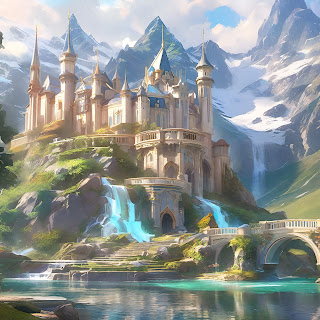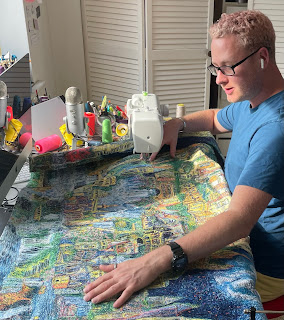Sanctuary of Emergence was created as an evolution of my previous piece, Citadel. I used an AI-generated image as a starting point, running Citadel through the app 'Wonder' and refining the outputs until I found a vision that resonated. This iterative process felt like a dialogue between past and future work, blending technology with my own handcraft.
An earlier version of a Wonder App generated castle scene based from an uploaded image of Citadel
I continued to generate new images and made amendments to image
This was the image image I chose from Wonder app
For me, Sanctuary of Emergence is about transforming dreams into something tangible. Castles, as symbols of escapism and imagination, were central to my vision. By using recycled bedding, the piece connects this sense of fantasy with the familiarity of everyday life. The softness of the fabric contrasts with the grandeur of the imagery, mirroring the way our aspirations and material reality are often interwoven.


As the piece developed, I reassessed its composition. A critique session with another artist, Ella Abel helped me reflect on the image overall. It led me to adjust the density of the buildings, introducing more foliage to create a natural rhythm between structures. This alteration made me reflect on the iterative nature of my practice—the way ideas evolve, not just through AI prompts but through continuous, hands-on modification. Even with a master template, no two pieces will be identical; each will be shaped by instinct and experimentation.
Sewing into the piece brought another layer of transformation. Every stitch altered the fabric’s tension, requiring careful management to maintain consistency. Building up tonal variations added depth and realism, while adjusting thread weight allowed me to create highlights, shadow, and half-tones. This intricate process reinforced my understanding of how to construct an image in textile form—both technically and artistically.
close up of Sanctuary of Emergence during its creationThe final piece feels like an achievement in process as much as in outcome. Compared to Citadel, Sanctuary of Emergence is more cohesive, distilling disparate elements into a unified composition. AI played a role in its inception, even influencing the title—generated through ChatGPT, which articulated my own intentions back to me in a way that felt both validating and illuminating. While AI serves as a tool for rapid ideation, my preference remains working from life, where materials and hands-on decisions shape the final work in ways technology cannot predict.
Reflecting on this project, I realise how much it embodies the themes of evolution and adaptation. It has pushed me to question my methods, embrace new materials, and refine my process. With the support of seam collective and the Arts Council England National Lottery Project Grant, I’ve had the freedom to experiment on a deeper level. Moving forward, I see this work as a foundation for further explorations—integrating sustainability, digital tools, and traditional craftsmanship in a way that continues to challenge and inspire my practice.
























.%20Image%20courtesy%20Meadow%20Arts.%20Photo%20by,%20Tegen%20Kimbley-24.jpg)
.%20Image%20courtesy%20Meadow%20Arts.%20Photo%20by,%20Tegen%20Kimbley-27.jpg)
.%20Image%20courtesy%20Meadow%20Arts.%20Photo%20by,%20Tegen%20Kimbley-4.jpg)








